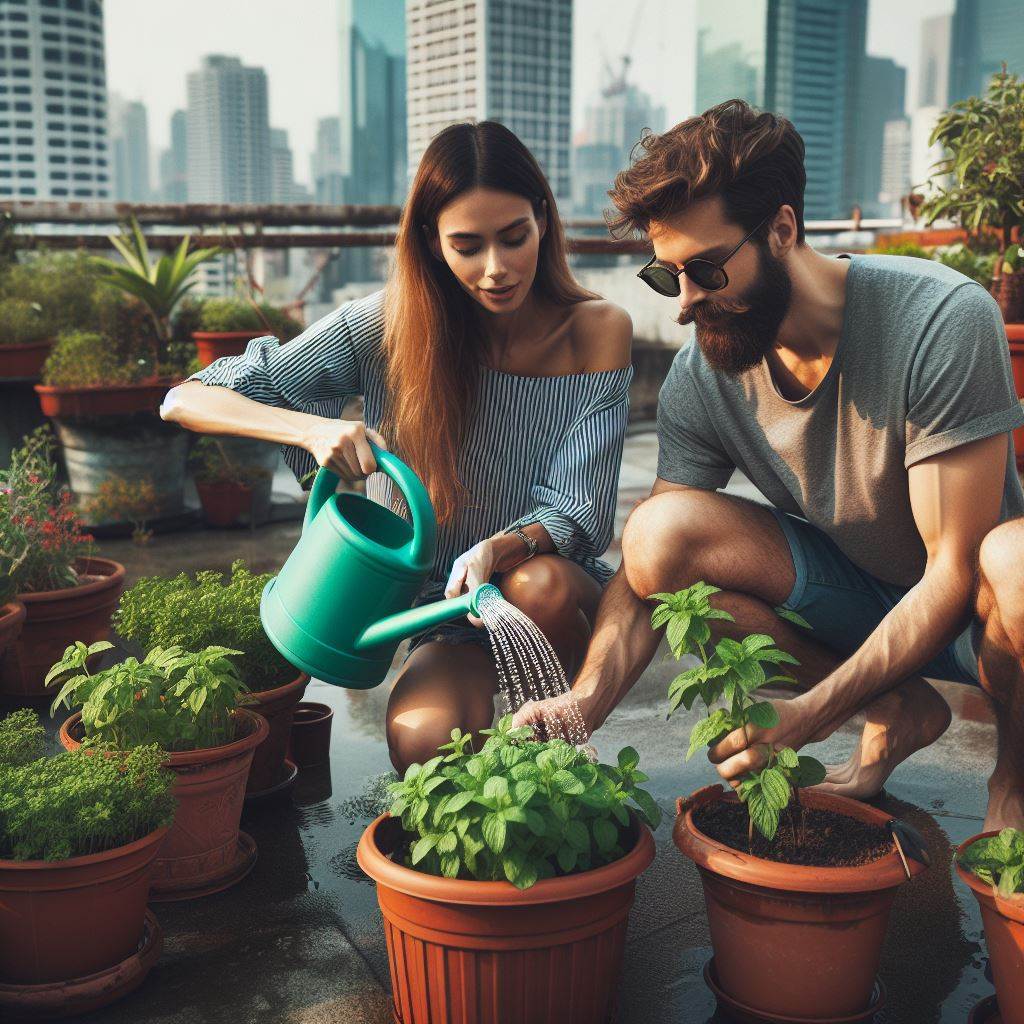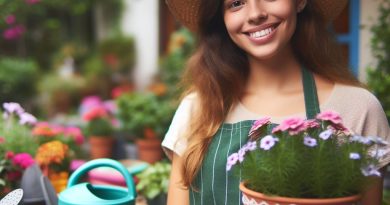Urban Green: Edible Plants in Pots
Last Updated on February 4, 2024
Introduction
Let’s explore urban green edible plants in pots.
Urban gardening refers to the practice of growing plants in urban areas.
Edible plants in urban areas are crucial for food security and sustainability.
The purpose of this blog post is to explore the benefits and techniques of growing edible plants in pots.
Urban gardening, the practice of growing plants in urban areas, has gained popularity in recent years.
People are realizing the importance of green spaces in cities and the positive impact they can have on the environment and well-being.
One aspect of urban gardening that deserves attention is the cultivation of edible plants in pots.
Edible plants play a significant role in urban areas.
They enhance food security by providing fresh produce to communities, especially in areas with limited access to grocery stores.
Furthermore, growing edible plants in pots encourages sustainability and self-sufficiency.
The purpose of this blog post is to educate and inspire readers on the benefits of growing edible plants in urban areas.
By using pots, individuals can turn even the smallest spaces, such as balconies or rooftops, into productive gardens.
This method is ideal for urban dwellers with restricted access to land.
Through this blog post, we will explore various techniques for successful pot gardening.
We will discuss suitable plants for pots, appropriate soil mixtures, and effective watering and fertilization methods.
Additionally, we will provide tips on pest control, the importance of sunlight, and the joy of harvesting fresh produce from one’s own urban garden.
By the end of this blog post, readers will have a clear understanding of the possibilities and advantages of growing edible plants in pots.
They will be empowered to take action and make a positive difference in their urban environment through urban green initiatives.
Benefits of Growing Edible Plants in Pots
Limited space requirements
- Pots allow for gardening in small spaces such as balconies, patios, and windowsills.
- Ideal for urban dwellers who lack access to large gardens or yards.
- Perfect solution for apartment residents who desire fresh produce.
Flexibility of placement
- Pots can be easily moved around, ensuring optimal sunlight and temperature for plant growth.
- Allows for experimentation with different locations to find the best growing conditions.
- Plants can be brought indoors during extreme weather conditions for protection.
Easy maintenance
- Potted plants require less maintenance compared to traditional gardens.
- Weeding is minimal or nonexistent, as pots provide a controlled environment.
- Fertilizing and watering are more manageable, allowing for better plant health.
Reduced risk of pests and diseases
- Pots help create a physical barrier against pests, such as snails and slugs.
- Easier to spot and address pest issues before they spread to other plants.
- Diseases are less likely to infect potted plants due to their isolated environment.
Shorter growth cycles
- Edible plants in pots grow faster than those in traditional gardens.
- Potted plants start indoors, transplanting outdoors when weather permits.
- Ideal for individuals desiring a quicker harvest.
Growing edible plants in pots benefits urban gardeners with limited space.
Pots allow cultivation of fruits, vegetables, and herbs on balconies, patios, or windowsills, offering fresh produce in small spaces.
The flexibility of pot placement ensures optimal sunlight and temperature, enabling experimentation for the best growing conditions.
Potted plants can be easily moved indoors during extreme weather conditions.
Easy maintenance is a key advantage of pot gardening, requiring less weeding, manageable fertilizing, and watering.
This makes it suitable for busy individuals or those with limited gardening experience.
Additionally, pot gardening reduces the risk of pests and diseases, acting as a barrier against pests like snails and providing a controlled environment for healthier growth.
Shorter growth cycles are appealing in pot gardening.
Edible plants in pots often have faster growth rates, allowing for quicker harvest by starting seeds indoors and transplanting when suitable.
This is especially beneficial for those eager to enjoy homegrown produce promptly.
In summary, growing edible plants in pots offers benefits like limited space requirements, flexible placement, easy maintenance, reduced pest and disease risks, and shorter growth cycles, making it a convenient and rewarding choice for urban gardening.
Read: Pollinators in the City: Urban Beekeeping
Basic Requirements for Growing Edible Plants in Pots
Selecting the right pots and containers
- Choose pots that are large enough to accommodate the plant’s root system.
- Ensure that the pots have drainage holes to prevent waterlogging.
- Consider the material of the pots – terracotta or plastic pots are commonly used.
- Opt for containers with good insulation properties to regulate soil temperature.
- Place pots in areas that receive adequate sunlight and are easily accessible for maintenance.
Choosing the appropriate soil mix
- Use a well-draining soil mix that allows water to flow through but retains adequate moisture.
- Ensure the soil mix is rich in organic matter to provide essential nutrients.
- Avoid using garden soil, as it may contain pests or diseases.
- Consider using potting mixes specifically formulated for growing edible plants in containers.
- Regularly check the pH level of the soil to ensure it remains within the appropriate range.
Providing adequate sunlight
- Place the pots in a location that receives at least 6-8 hours of direct sunlight daily.
- When growing indoors, use grow lights to supplement natural sunlight.
- Monitor the plants closely to check for signs of insufficient or excessive sunlight.
- Rotate the pots regularly to ensure all sides of the plant receive equal sunlight exposure.
- Adjust the position of the pots depending on the seasonal changes in sunlight intensity.
Watering and fertilizing techniques
- Water the plants when the top inch of the soil feels dry, but avoid overwatering.
- Ensure that water reaches the root zone by using a watering can or drip irrigation method.
- Consider using self-watering pots or adding a water reservoir to prevent underwatering.
- Fertilize plants regularly using organic fertilizers or slow-release fertilizers.
- Follow the recommended dosage and fertilizing schedule for each specific plant.
Monitoring plant growth and health
- Regularly inspect plants for signs of pests, diseases, or nutrient deficiencies.
- Prune plants to maintain their shape, encourage bushier growth, and remove damaged parts.
- Monitor soil moisture levels using a moisture meter or by digging a small hole in the soil.
- Observe the overall health and vigor of the plants and address any issues promptly.
- Keep a gardening journal to record observations, treatments, and improvements over time.
Read: Water-Wise Urban Gardening Essentials
Popular Edible Plants for Container Gardening
When it comes to urban gardening, container gardening is a popular choice.
Not everyone has access to a large plot of land, but that doesn’t mean you can’t grow your own food. One way to do this is by growing edible plants in pots.
Herbs
- Basil is a popular herb that can be easily grown in a pot. Its fresh leaves are perfect for adding flavor to various dishes.
- Mint is another herb that thrives in containers. Its refreshing leaves are great for making teas or garnishing desserts.
- Rosemary is a woody herb that adds a fragrant aroma to dishes. It can be grown in a pot and harvested as needed.
Leafy greens
- Lettuce is a versatile leafy green that can be grown in containers. It’s perfect for salads and sandwiches.
- Spinach is another nutritious leafy green that can be easily grown in pots. It’s packed with vitamins and minerals.
- Kale is a trendy superfood that can also be grown in containers. Its nutrient-rich leaves are great for salads and smoothies.
Tomatoes
- Determinate tomatoes, suited for containers, yield well in limited space.
- Cherry tomatoes, ideal for snacking and salads, thrive in container gardens.
- Heirloom tomatoes, offering diverse colors and flavors, enhance container gardens.
Container gardening, especially for urban dwellers, provides access to fresh and nutritious food at home, adding vibrancy to the surroundings.
To succeed in pot gardening, choose the right container size based on the plant’s needs, ensuring well-draining soil mixtures.
Proper drainage and regular watering are crucial, considering the faster drying of containers.
Sunlight is essential, requiring a sunny location for at least six hours daily or supplementing with grow lights.
Maintain plant health through regular pruning, pinching herbs for bushiness, and harvesting as needed, leaving enough leaves for continued growth.
In fact, container gardening transforms urban spaces into vibrant mini gardens.
Whether a small balcony or tiny backyard, you can grow herbs, leafy greens, and tomatoes, experiencing the joy of homegrown, delicious food.

Tips and Tricks for Successful Container Gardening
Achieving success in container gardening requires careful attention and proper techniques.
Here are some tips and tricks to help you maintain healthy and productive edible plants in pots:
Proper spacing and positioning
- Choose a container that is suitable for the size and growth habit of the plants you intend to grow.
- Ensure there is adequate space between plants to allow for air circulation and prevent overcrowding.
- Position the pots in an area that receives the appropriate amount of sunlight for the specific plants.
Regular pruning and harvesting
- Regularly prune your plants to promote bushier growth and prevent them from becoming leggy.
- Harvest your plants frequently to encourage continuous production and prevent them from going to seed.
- Use clean and sharp tools to avoid damaging the plants while pruning and harvesting.
Companion planting for pest control
Utilize companion planting techniques to naturally deter pests and attract beneficial insects.
Plant aromatic herbs like basil, rosemary, and lavender to repel common garden pests.
Interplant flowers such as marigold and nasturtiums to attract pollinators and beneficial insects.
Vertical gardening techniques
- Make the most of limited space by implementing vertical gardening techniques in your container garden.
- Use trellises, stakes, or cages to support climbing plants like tomatoes, cucumbers, or beans.
- Invest in vertical planters or hanging baskets to maximize vertical space for growing herbs and flowers.
Winterizing potted plants
- Before the onset of winter, protect your potted plants from extreme cold and frost damage.
- Move the containers to a sheltered area or wrap them with insulating materials like burlap.
- Water the plants adequately but avoid overwatering to prevent root rot during the dormant period.
By following these tips and tricks, you can ensure the success of your container gardening endeavors.
Remember, proper spacing, regular maintenance, companion planting, vertical techniques, and winter preparations are key to a thriving urban green space.
Read: Tiny Orchard: Fruit Trees in Pots
Potential Challenges and How to Overcome Them
When it comes to growing edible plants in pots in urban areas, there are several potential challenges that you may face.
However, with the right approach and some problem-solving techniques, these challenges can be overcome.
Lack of Space
One of the most common challenges faced by urban gardeners is the lack of space.
If you live in a small apartment or have a tiny balcony, finding room for edible plants can be difficult.
However, there are a few solutions that can help you make the most of your limited space:
- Use vertical gardening techniques, such as hanging baskets or wall-mounted planters.
- Opt for compact varieties of edible plants that take up less space.
- Consider using window boxes or railing planters to maximize your planting area.
Limited Sunlight Exposure
Another challenge in urban environments is the limited sunlight exposure. Tall buildings and shadowy surroundings can hinder the growth of your edible plants.
To overcome this challenge:
- Choose edible plants that can thrive in shady conditions, such as leafy greens.
- Place your pots in the sunniest spots of your living space, such as near windows or on balconies.
- Consider using reflective surfaces or mirrors to redirect sunlight towards your plants.
Soil Quality Issues
The soil in urban areas is often contaminated with pollutants, making it unsuitable for growing edible plants. To overcome soil quality issues:
- Use raised beds or containers with high-quality potting soil to create a separate growing environment.
- Consider soil testing to identify any potential contaminants and take appropriate measures to address them.
- Start a composting system to produce nutrient-rich compost that can be used to improve soil quality.
Pests and Diseases
Urban gardens are vulnerable to pests and diseases due to their close proximity to other gardens and wildlife. To protect your edible plants:
- Regularly check your plants for any signs of pests or diseases and take immediate action.
- Encourage natural predators, like ladybugs or birds, to keep the pest population under control.
- Practice good hygiene by cleaning your pots and tools regularly to prevent the spread of diseases.
Weather Conditions
Weather conditions can be unpredictable, especially in urban areas. Extreme temperatures, strong winds, and heavy rains can negatively impact your edible plants.
Here’s how you can deal with weather-related challenges:
- Provide protection to your plants during harsh weather conditions, such as using row covers or temporary shelters.
- Water your plants carefully, considering the weather patterns and adjusting the frequency and amount of watering accordingly.
- Choose plant varieties that are resilient to the local climate and can withstand a wide range of weather conditions.
By addressing these potential challenges and implementing the suggested solutions, you can successfully grow edible plants in pots even in urban settings.
Don’t let the limitations deter you from enjoying the benefits of urban greenery and the satisfaction of growing your own food!
Read: Indoor Edibles: Grow Food Inside
Final Thoughts
Recap of the benefits of growing edible plants in pots
Growing edible plants in pots brings fresh and organic produce right to your doorstep.
It allows you to save space and create a beautiful green oasis in your urban environment.
You have complete control over the soil quality and can easily manage pests and diseases.
Encouraging readers to start their own urban container garden
Why wait? Start your own urban container garden and experience the joy of growing your own food.
No matter how small your space is, there’s always room for a few pots and some herbs or vegetables.
You’ll be amazed by the satisfaction and fulfillment that comes with harvesting and eating your own homegrown produce.
Suggesting additional resources for further guidance
If you want to learn more about urban gardening, there are plenty of resources available.
Books like “The Container Vegetable Gardener” by Maggie Barry provide a wealth of information.
Websites and online communities such as Urban Gardening subreddit can also offer valuable advice and inspiration.
In closing, growing edible plants in pots is not only practical but also incredibly rewarding.
By recapping the benefits, encouraging readers to start their own container garden, and providing additional resources, we hope to inspire and guide you on your urban gardening journey.


